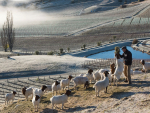Kinross Awarded
Gibbston's Kinross won the inaugural 2024 Qualmark New Zealand Wine Tourism Award, presented at the Altogether Unique 2024 industry celebration dinner in Wellington in late August.
Back in 2011, an ambitious three-year project began, looking at what it took, cost and involved to turn a vineyard from conventional to organic.
Known as the Organic Focus Vineyard project, it involved vineyards in Hawke’s Bay, Marlborough and Central Otago. Each company agreed to convert a block, monitor it carefully and provide in-depth data to quantify all costs, issues and results. (The full report of the Organic Focus Vineyard project is available on the OWNZ website.)
So now a few years on – how are those three vineyards; Mission Estate growing Syrah and Merlot, Wither Hills with Pinot Noir and Sauvignon Blanc, and Gibbston Valley Wines growing Pinot Noir and Pinot Gris doing? A number of questions were put to each company, and the answers were highlighted at the recent Organic and Biodynamic Winegrowing Conference.
The good news is that each of the three sites has been retained as organic and Gibbston Valley has since increased its organic area to 35 percent of total vineyard.
Have the wines made from organic grapes lived up to expectation?
Mission Estate
We have kept fruit separate in the winery and the organic sections of Merlot and Syrah have better flavour concentration and texture.
Wither Hills
The Focus Vineyard Blocks have been on sold to various producers since the completion of the project. This is because Wither Hills is also a contract winemaking facility which grows to various specifications for clients.
Gibbston Valley
The wines made now from the organic grapes are more consistent in quality and flavour profile. They are expressive, exciting and unique. The primary and secondary fermentations are largely not inoculated and require less fermentation nutrition.
Has the fruit from the organic areas behaved/looked/responsded differently to the conventional fruit?
Mission Estate
The vines have less vigour and are lighter cropped. No apparent differences in fruit, brix, TA, colour and tannins are similar.
Wither Hills
The Pinot Noir is continuing to improve. Plants are healthy with balanced canopy growth and crop levels between 5 – 6t/ha. The block has also shown substantial resistance to botrytis and powdery mildew over the past few seasons. A lighter weight canopy and loose bunch architecture has helped to significantly reduce disease pressure.
In the Sauvignon Blanc which had a shift in vigour after year three, has plateaued. Yields are at a level of 12 – 14 t/ha.
Gibbston Valley
Smaller canopies and a smaller yield in the organic areas, however as per the previous question very happy with the resulting fruit.
Several years on what new learnings, if any, have you made? Would/could you do anything differently?
Mission Estate
No. The soil type suits cultivation and the vineyard is irrigated. This alleviates some of the problems (soil quality and de-vigorisation) that some vineyards will get with cultivation for weed control. Also the lower yields we are getting, are close to what we are targeting for our premium level wines.
Wither Hills
The addition of the Rolhacke (Braun attachment) to our undervine arsenal has allowed us to get better control of weeds especially in heavier soil.
In V17 we saw significant mealy bug pressure in conventional blocks, there is mealy bug in the organic area but it hasn’t been a problem thus far.Gibbston Valley
Don’t under estimate how hungry the site was and how much nutrient replacement and soil nutrient building was required to maintain production on a lean site and a site that had been otherwise fed plenty of supplementary fertigation.
Root damage, root replacement, dry seasons, mid row competition and undervine weed growth all have an impact, but it’s difficult to pinpoint what is the critical factor.
We probably needed twice as much compost and to apply it every year to buffer the change in growing system at the School House vineyard.

The end of the year is fast approaching, so here are some thoughts on a few of the significant developments…

OPINION: When I moved to Marlborough two decades ago, I found countless lines of tidy vines, neatly mowed and carefully…
The large 2025 harvest will exacerbate the wine industry's "lingering" supply from recent vintages, New Zealand Winegrowers Chief Executive Philip…
If you find a new consumer in a developed wine market, you are taking them from someone else, says Blank…
A New Zealand startup is providing growers with vital information for daily operations and long-term vineyard management, using a unique…